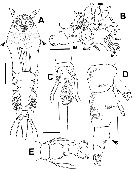|
|
 |
|
Monstrilloida ( Order ) |
|
|
|
Monstrillidae ( Family ) |
|
|
|
Cymbasoma ( Genus ) |
|
|
| |
Cymbasoma tharawalorum Suarez-Morales & McKinnon, 2016 (F) | |
| | | | | | | Ref.: | | | Suarez-Morales & McKinnon, 2016 (p.110, Descr. F, figs. F, Rem.) |  ssued from : E. Suarez-Morales & A.D. McKinnon in Zootaxa, 2016, 4102. [p.111, Fig.64]. Female (from 38°4.670'S, 151°9.100'E): A, habituis (lateral); B, cephalic region (lateral); C, same (ventral); D, P2 with intercoxal sclerite (arrow indicates expanded outer margin of 1st and 2nd endopodal segments); E, P1 with intercoxal sclerite; F, P3 with intercoxal sclerite. Scale bars: A = 200 µm; B-F = 100 µm. Nota: Cephalothorax representing about 57 % of total body length. - Midventral oral papilla protuberant, located at 26 % of cephalothorax length. - Pair of relatively small ocelli, pigment cups moderately developed, medially separated, weakly pigmented on reduced inner area; ventral cup larger than lateral cups. - Frontal sensilla absent. - Urosome consisting of 5th pedigerous somite, genital double-somite and anal somite, representing 23 % of total body length. Relative lengths of urosomites 33.5 : 42.8 : 23.7 = 100. - Anal somite with ventral protuberance. - Caudal ramus subrectangular, 1.6 times longer than wide, armed with 3 subequally long, sparsely setulated caudal setae. - Ovigerous spines paired, relatively short, 45 % of total body length; spines basally separated, one spine slightly shorter.
|
 Issued from : E. Suarez-Morales & A.D. McKinnon in Zootaxa, 2016, 4102. [p.112, Fig.65]. Female: A, habitus (dorsal); B, right A1 (dorsal); C, urosome (ventral); D, same enlarged, lateral view, arrow indicates ventral expansion of anal somite; E, urosome (dorsal). Scale bars: A = 200 µm; B, C, E = 100 µm; D = 50 µm. Nota: A1 relatively short, representing about 16.5 % of total body length, and 30 % of cephalothorax length; 4-segmented, segments 3 and 4 compressed; relative length of short distal segment 42.5 %. - P5 medially separated, bilobate, outer (exopodal) lobe elongate, distally truncate, reaching about 1/3 length of genital double-somite, armed with 2 subequally long setae on distal position. Inner lobe represented by small, rounded process inserted at middle inner margin of main lobe.
|
 ssued from : E. Suarez-Morales & A.D. McKinnon in Zootaxa, 2016, 4102. [p.113]. Female: Armature formula of swimming legs P1 to P4.
| | | | | NZ: | 1 | | |
|
Distribution map of Cymbasoma tharawalorum by geographical zones
|
| | | | Loc: | | | SE Australia (Port Hacking, New South Wales)
Type locality: 38°4.670' S, 151°9.100' E. | | | | N: | 1 | | | | Lg.: | | | (1198)* F: 1,07; {F: 1,07}
* Body length measured from the anterior end cephalothorax to the posterior end of the anal somite. | | | | Rem.: | For Suarez-Morales & McKinnon (2013, p.113) the species is assignable to the agoense Group. It differs from C. agoense in the shape and structure of the P5 inner lobe; both setae on the outer lobe are distal in C. Tharawalorum whereas 1 is distal and the other is subdistal in C. agoense (Sekiguchi, 1982: fig.6F), they differ also in the body proportions and the 5th pedigerous somite. | | | Last update : 04/10/2016 | |
|
|
 Any use of this site for a publication will be mentioned with the following reference : Any use of this site for a publication will be mentioned with the following reference :
Razouls C., Desreumaux N., Kouwenberg J. and de Bovée F., 2005-2025. - Biodiversity of Marine Planktonic Copepods (morphology, geographical distribution and biological data). Sorbonne University, CNRS. Available at http://copepodes.obs-banyuls.fr/en [Accessed January 05, 2026] © copyright 2005-2025 Sorbonne University, CNRS
|
|
 |
 |





